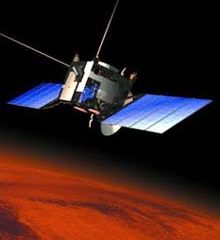This area deals with the fundamental laws and building blocks of nature and how they interact, the properties and the behavior of matter, and research into space and time and their structures.
innovations-report provides in-depth reports and articles on subjects such as astrophysics, laser technologies, nuclear, quantum, particle and solid-state physics, nanotechnologies, planetary research and findings (Mars, Venus) and developments related to the Hubble Telescope.

During recent observations from the ESA Mars Express spacecraft in orbit around Mars, methane was detected in its atmosphere.
Whilst it is too early to draw any conclusions on its origin, exciting as they may be, scientists are thinking about the next steps to take in order to understand more.
From the time of its arrival at Mars, the Mars Express spacecraft started producing stunning results. One of the aims of the mission is analysing in detail the chemical composition of the M

Very Large Telescope sets stringent limit on possible variation of the fine-structure constant over cosmological time
A fine constant
To explain the Universe and to represent it mathematically, scientists rely on so-called fundamental constants or fixed numbers. The fundamental laws of physics, as we presently understand them, depend on about 25 such constants. Well-known examples are the gravitational constant, which defines the strength of the force acting between tw

Astronomers have discovered ten previously unknown likely black holes in the Andromeda Galaxy by means of a powerful new search technique they have devised. The Andromeda Galaxy is the nearest neighbouring spiral galaxy, 2.5 million light years away. Drs Robin Barnard, Ulrich Kolb and Carole Haswell of the Open University and Dr Julian Osborne of The University of Leicester used the European Space Agency’s XMM-Newton orbiting X-ray observatory to find what are probably black holes lurking in dou

Gamma ray bursts (GRBs) are the most powerful explosions in the Universe, yet it is only in the last few years that astronomers have started to understand them. This ongoing quest to solve the mysteries of gamma ray bursts will be boosted next September when a new US/UK/Italian space observatory, called Swift, will be launched.
Dr. Julian Osborne (University of Leicester) will describe this exciting mission and the discoveries that can be expected from Swift on Tuesday 30 March, during the

Mathematicians test simplified formula to predict winning baseball percentages
Is your local Major League Baseball team better than its record suggests? Math researchers are considering alternatives to the Pythagorean Theorem of Baseball, devised by baseball statistician Bill James. Introduced in the 1980s, the “theorem” predicts the winning percentage of a baseball team based on how many runs the team scores–and how many runs it allows.
Websites, including ESPN’s, oft

Research by Young-June Kim, a physicist at the U.S. Department of Energy’s Brookhaven National Laboratory, may help determine how a class of materials already used in electronic circuits could be used in optical, or light-based, circuits, which could replace standard electrical circuits in telecommunications, computer networking, and other areas of technology.
Kim’s research is focused on “quasi one-dimensional” cuprates, materials that contain copper and oxygen where the atoms ar